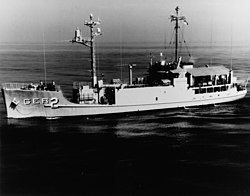Function
These ships carried a crew of U.S. Navy personnel whose specialty was intercepting wireless electronic communications and gathering intelligence from those communications (signals intelligence, communications intelligence, and electronic signals intelligence (SIGINT)). In the 1960s those personnel had a U.S. Navy rating of Communications Technician (later changed to Cryptologic Technician), or CT.
In order to transmit intelligence information that had been gathered back to United States for further processing and analysis, these ships had a special system named Technical Research Ship Special Communications, or TRSSCOM (pronounced tress-com). [3] This Earth-Moon-Earth (EME) communications system used a special gyroscope-stabilized 16-foot (4.9 m) parabolic antenna, which can be seen aft of the main superstructure in the accompanying photographs of Belmont and Liberty. Radio signals were transmitted toward the Moon, where they would bounce back toward the Earth and be received by a large 84-foot (26 m) parabolic antenna at a Naval Communications Station in Cheltenham, Maryland (near Washington, D.C.) or Wahiawa, Hawaii. Communications could occur only when the Moon was visible simultaneously at the ship's location and in Cheltenham or Wahiawa. The gyro stabilization of the antenna kept the antenna pointed at the Moon while the ship rolled and pitched on the surface of the ocean.
These ships were classified as naval auxiliaries with a hull designation of AGTR, which stands for Auxiliary, General, Technical Research. Five of these ships were built with hull numbers of 1–5. The first three ships of this type (Oxford, Georgetown, and Jamestown) were converted from World War II-era Liberty ships. The last two ships (Belmont and Liberty) were converted from Victory ships. [3] The former Liberty ships' top speed of 11 knots (20 km/h; 13 mph) limited the first three AGTRs to missions of slow steaming on station with a minimum of transits. [3] Victory ships' sustained speed of 18 knots (33 km/h; 21 mph) enabled Belmont to shadow Mediterranean Sea operations of the Soviet helicopter carrier Moskva in 1969. [3] All of the technical research ships were decommissioned and stricken by 1970.
One of these ships' crew received a Presidential Unit Citation for heroism in combat. USS Liberty was attacked, severely damaged and 34 crew members killed by shelling, napalm bombing and torpedoing from Israeli jet fighter aircraft and motor torpedo boats on June 8, 1967.
USS Jamestown was awarded a Meritorious Unit Commendation along with USS Oxford. The citation reads (in part) "For meritorious service from 1 November 1965 to 30 June 1969 while participating in combat support operations in Southeast Asia. Through research and the compilation of extremely valuable technical data, USS Jamestown and USS Oxford contributed most significantly to the overall security of the United States and other Free World forces operating in support of the Republic of Vietnam. Signed E.R. Zumwalt, Admiral, USN, Chief of Naval Operations."
For specifications of these ships, see Liberty ship and Victory ship.
This page is based on this
Wikipedia article Text is available under the
CC BY-SA 4.0 license; additional terms may apply.
Images, videos and audio are available under their respective licenses.


